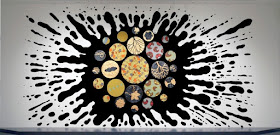 |
| Cocotte Reading - from Pissarro's People |
At this time a year ago, I was crowing about how much traffic had increased on the site during its second full year. Well, this third year has seen the traffic rate double, tallying about 40,000 page views in 2011, with a peak of just under 5,000 for the month of November. Admittedly, a good number of those are probably just folks in Uzbekistan trolling for Norman Rockwell images to steal - but, hey, I'm not choosy!
 |
| George Rickey - Four Squares from Sculpture in the Streets |
Our regional cultural scene has also held up well despite the odds and the never-ending economic crisis that continues to hurt the arts more than any other category. This year we witnessed the birth of MoHu (still a work in progress, but a welcome addition to the overall energy); the near eviction of Upstate Artists Guild (still in intensive care but, hopefully, out of the woods); the death of Nadia Trinkala; and a wave of leadership changes at such institutions as the Williams College Museum of Art, The Albany Institute of History & Art, The Arts Center of the Capital Region, the Berkshire Museum, Fulton Street Gallery, Albany Center Gallery, Union College's Mandeville Gallery, and probably more that I don't know about or can't recall.
 |
| cant and wont - from Victoria Palermo: RAUM |
 |
| Arm - from Mark McCarty: Skin |
The Top Eleven
- Tangible Marking: The Dimensional Drawings of Creighton Michael at Esther Massry Gallery
- Objects of Wonder & Delight: Four Centuries of Still Life at The Hyde Collection
- M.C. Escher: Seeing the Unseen at Berkshire Museum
- Jim Boden and Alison Denyer at Lake George Arts Project
- Environment and Object: Recent African Art at the Tang Teaching Museum
- Sculpture in the Streets (George Rickey) in Downtown Albany
- Pissarro's People at the Sterling and Francine Clark Art Institute
- Reflections on a Museum at Williams College Museum of Art
- Thom O'Connor: Then and Now at Albany Center Gallery
- Mark McCarty: Skin at Opalka Gallery
- Victoria Palermo: RAUM at John Davis Gallery
Also outstanding:
- Eco Primitive Eco Surreal at Albany Center Gallery
- Willie Marlowe: A Survey 1977-2010 at Opalka Gallery
- The Landscape of Memory: Prints by Frank C. Eckmair at New York State Museum
- Blinky Palermo at CCS Bard and Dia:Beacon
- Harold Lohner: Gathering at Opalka Gallery
- Céleste Boursier-Mougenot at EMPAC
- Richard Deon: Paradox and Conformity at the Arts Center of the Capital Region
It's worth pointing out that Sage College of Albany's Opalka Gallery made the list three times - that's because the Opalka has made a rare commitment to mounting solo shows by outstanding regional artists who may have been unjustly overlooked. It just happened that three of those shows came in the same year.
All in all, it was quite a year for most of the Capital Region's exhibiting venues - a good sign that the future remains bright in the region. For all of them, and all of you - here's to an outstanding 2012! And thanks for reading ...
All in all, it was quite a year for most of the Capital Region's exhibiting venues - a good sign that the future remains bright in the region. For all of them, and all of you - here's to an outstanding 2012! And thanks for reading ...
 |
| Yinka Shonibare - Black Gold I - from Environment and Object: Recent African Art |





